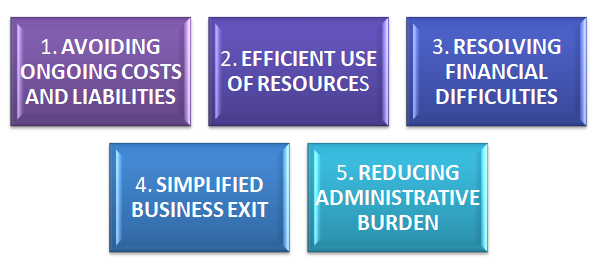Close a Limited Liability Partnership
A Limited Liability Partnership (LLP) is a popular business structure that provides its members with the flexibility of a partnership while limiting personal liability. However, there may come a time when the LLP needs to be closed due to various reasons, such as the completion of the business's objectives, financial difficulties, or a change in the owners' circumstances. Properly closing an LLP is crucial to avoid any legal or financial consequences.
Closing an LLP is a significant decision that requires careful planning and execution. It is essential to follow the legal procedures and meet all the obligations to avoid potential legal liabilities and penalties. Seeking professional advice from an accountant or a legal expert during the winding-up process can be beneficial in navigating through the complexities and ensuring a successful closure. By closing the LLP properly, the partners can move on to new opportunities while safeguarding their interests and reputation in the business world.
LEGAL PROVISIONS FOR CLOSURE OF LLP OR STRIKE OFF OF AN LLP
Any LLP can close down its business by adopting any of the following two ways:
A) Declaring the LLP as Defunct
In case the LLP wants to close down its business or where it is not carrying on any business operations for the period of one year or more, it can make an application to the Registrar for declaring the LLP as defunct and removing the name of the LLP from its register of LLP’s.
eForm 24 is required to be filed for striking off the name of LLP under clause (b) of sub rule 1 of Rule 37 of LLP Rules 2008. Similarly, Registrar also has the power to strike off any defunct LLP after satisfying himself of the need to strike off and has reasonable cause. However, in this case, registrar has to send a notice to the LLP of his intention and request to send their representation within one month from the date of the notice. The Registrar shall publish such notice or content of the application made by the LLP on its website for a period of one month for the information of the general public. In case no reply is received within the mentioned period, registrar may strike off the name of LLP.
B) Winding up of LLP
Section 63, 64 and 65 of LLP Act 2008 governs the process for winding up of the LLP. It is the process where all the assets of the business are disposed off to meet the liabilities of the same and surplus any, is distributed among the owners. The LLP Act 2008 provides for following two modes for winding up the LLP.
- Voluntary winding up
- Compulsory winding up
1. Voluntary Winding up: Under this, the partners may between themselves decide to stop and wound up the operations of the LLP.
2. Compulsory winding up: A limited liability partnership may be compulsorily wound up by the Tribunal-
- If the limited liability partnership decides that limited liability partnership be wound up by the Tribunal;
- If, for a period of more than six months, the number of partners of the limited liability partnership is reduced below two;
- If the limited liability partnership is unable to pay its debts;
- If the limited liability partnership has acted against the interests of the sovereignty and integrity of India, the security of the State or public order;
- If the limited liability partnership has made a default in filing with the Registrar the Statement of Account and Solvency or annual return for any five consecutive financial years; or
- If the Tribunal is of the opinion that it is just and equitable that the limited liability partnership be wound up.
SOME OF THE KEY ADVANTAGES OF CLOSING AN LLP INCLUDE:

1. Avoiding Ongoing Costs and Liabilities: By closing the LLP, partners can stop incurring ongoing costs associated with running the business, such as maintenance fees, annual filings, and regulatory compliance expenses. Additionally, closing the LLP helps to limit any further liability for future debts or obligations, providing partners with peace of mind.
2. Efficient Use of Resources: If the LLP is no longer profitable or aligned with the partners' business objectives, closing it allows the partners to redirect their time, energy, and resources toward more promising ventures or personal endeavors.
3. Resolving Financial Difficulties: In cases where the LLP is facing financial difficulties or mounting debts, closure can help to resolve these issues by liquidating assets to pay off debts and distribute any remaining assets among the partners. This can help to protect the partners' personal assets from creditors.
4. Simplified Business Exit: For partners who wish to retire, pursue other opportunities, or part ways amicably, closing the LLP provides a clear and formalized process for ending their business relationship. This avoids potential disputes in the future and ensures a smooth transition.
5. Reducing Administrative Burden: Closing an LLP involves filing appropriate forms and fulfilling certain regulatory requirements. However, once the winding-up process is completed, partners are relieved from the ongoing administrative burden associated with running a business, such as record-keeping, reporting, and compliance.
DOCUMENTS REQUIRED FOR CLOSING LLP
Closing a Limited Liability Partnership (LLP) involves several essential documents that need to be prepared and filed with the relevant regulatory authorities. The specific documents required may vary based on the jurisdiction and local regulations. However, the following are commonly required documents for closing an LLP:
1. Board Resolution or Partners' Consent: A board resolution or written consent from all partners is necessary to approve the decision to wind up the LLP. This document should clearly state the reasons for closure and the appointment of a liquidator.
2. Notice of Closure: LLPs typically need to file a "Notice of Closure" or "Application for Striking Off" with the appropriate government department or the registrar of companies. This document formally notifies the authorities of the LLP's intention to close.
3. Statement of Assets and Liabilities: A statement of assets and liabilities must be prepared by the LLP's partners, providing a detailed overview of the LLP's financial position at the time of closure.
4. Statement of Accounts: Partners should prepare a final statement of accounts that includes the LLP's financial transactions up to the date of closure. This document should reflect the settlement of all debts and liabilities.
5. Minutes of Meetings: Minutes of the meetings where partners decided to wind up the LLP and appointed the liquidator should be documented and maintained as part of the records.
6. Consent of Creditors: The LLP must obtain the consent of all creditors for the closure process. Alternatively, the LLP should provide them with the opportunity to submit their claims against the LLP.
7. Declaration by Partners/Liquidator: A declaration signed by the partners or the liquidator affirming that all debts and liabilities have been settled, and the assets have been distributed according to the profit-sharing ratio.
8. Consent of Regulatory Authorities (if applicable): If the LLP is regulated by specific authorities, such as professional bodies or industry regulators, consent for the closure may be required.
9. Tax Clearance Certificate: In some jurisdictions, a tax clearance certificate may be necessary to verify that all tax liabilities have been settled before the closure of the LLP.
10. Consent of Partners: The partners should provide their consent to dissolve the LLP and close its operations. This may involve signing a formal agreement or document.
11. Statutory Filings: Apart from the specific documents mentioned above, there may be other statutory filings required by the local authorities for the closure process. These could include updating the LLP's status with the registrar of companies.
PROCESS FOR CLOSING LLP
The general outline of the steps involved in closing an LLP:
1. Decision to Close: The first step is for the partners to collectively decide to close the LLP. This decision should be documented in writing and signed by all partners.
2. Appointing a Liquidator: The partners need to appoint a liquidator who will be responsible for overseeing the winding-up process. The liquidator can be a partner or an external professional, such as a qualified accountant or an insolvency practitioner.
3. Settling Debts and Liabilities: Before proceeding with the closure, all outstanding debts and liabilities of the LLP should be settled. The liquidator must notify all creditors about the LLP's closure and provide them with an opportunity to submit their claims.
4. Distribution of Assets: Once all debts and liabilities have been settled, the remaining assets of the LLP can be distributed among the partners according to their profit-sharing ratio. The liquidator is responsible for ensuring a fair distribution.
5. Form for Closure Filing (LLP Form 24): In India, for the closure of an LLP, Form 24 needs to be filled with the Ministry of Corporate Affairs (MCA). Form 24 is the application for striking off the name of the LLP from the Registrar of Companies (ROC) records.
6. Public Notice (if required): In some jurisdictions, the LLP may be required to publish a public notice of its intention to close in a designated newspaper.
7. Consent of Creditors (if required): If required by local regulations, the LLP must obtain the consent of all creditors for the closure process.
8. Tax Clearance Certificate: Obtain a tax clearance certificate or a similar document from the tax authorities to verify that all tax liabilities have been settled.
9. Final Tax Returns and Compliance: File the LLP's final tax return and ensure that all necessary tax payments are made before the dissolution is completed. Additionally, fulfill any other regulatory compliance requirements, such as the submission of financial statements, if applicable.
10. Informing Stakeholders: Notify clients, customers, suppliers, and employees about the decision to close the LLP. Transparent communication is essential for a smooth transition for all parties involved.
11. Record Keeping: Maintain proper records of all the steps taken during the winding-up process, including financial statements, minutes of meetings, and documentation of the distribution of assets.
12. Obtain Dissolution Certificate: Once all the required procedures are completed, the LLP will receive a dissolution certificate from the relevant authorities, confirming the closure.
FAQS
Q.1.How do I close my LLP?
Ans: File Form 24 with the Ministry of Corporate Affairs (MCA) and settle all debts and liabilities before distributing assets among partners.
Q.2. What is the role of a liquidator in LLP closure?
Ans: The liquidator oversees the winding-up process, collects assets, settles debts, and distributes remaining assets among partners.
Q.3.Can LLP be closed voluntarily?
Ans: Yes, LLP can be voluntarily closed by passing a resolution and filing Form 24 with the appropriate authorities.
Q.4. How long does it take to close an LLP?
Ans: The timeline varies, but it may take several months to complete the LLP closure process.
Q.5. Do I need to inform creditors and stakeholders?
Ans:Yes, notifying creditors and stakeholders about LLP closure is essential for a smooth transition.
Q.6. What are the tax implications of closing an LLP?
Ans: File final tax returns, obtain a tax clearance certificate, and settle all tax liabilities before closing the LLP.
Q.7. Can I reopen a closed LLP?
Ans: No, once an LLP is closed, it cannot be reopened; a new LLP must be formed if needed.
Q.8. Is there a specific order to follow in LLP closure?
Ans: Settle debts, distribute assets, file Form 24, fulfill tax and regulatory requirements, and inform stakeholders.
Q.9. What if the LLP has no activity before closure?
Ans: Even inactive LLPs must go through the proper closure process and file the required forms.
Q.10. Are there penalties for not closing an LLP properly?
Ans: Failure to follow the correct closure procedure may result in legal liabilities and penalties.

